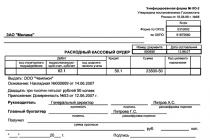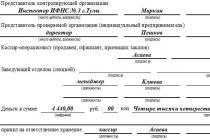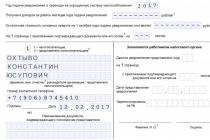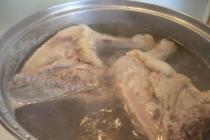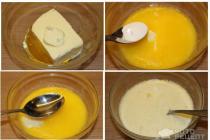To reflect information about cash in the cash register at the time of inspection, a special official reporting document is generated - an act.
FILES
Why do you need a cash verification report?
Cash in the cash register is checked periodically. Moreover, most often, inspections are sudden. The initiative for such control actions can come from both the management of the enterprise and the supervisory authorities.
Regardless of who organized the inspection, an act is drawn up based on its results. They fit into it
- the amount that should be in the cash register according to accounting documents,
- as well as the amount that actually turned out to be available when the inspectors counted it.
In this way, the financial and cash discipline of the company is monitored, facts of official violations, abuses, shortages, etc. are revealed. illegal phenomena.
Who checks the cash register?
If the audit is carried out within the company, then a commission consisting of at least three people is created for this event. Usually, directors are included in it by a separate order
- accountant,
- management representative,
- head of one of the structural divisions of the organization.
The financially responsible employee must also be present during these actions, but he is not included in the commission.
In cases where the inspection is carried out as part of on-site tax control, inspectors from the supervisory department are also added to all the above-mentioned persons.
What consequences can an audit have?
If, based on the results of control measures, no violations are revealed, and the cash matches to the last penny what is indicated in the documents, then, of course, there will be no consequences. But if during the inspection it turns out that there is less or more money in the cash register (this also happens) than there should be in accordance with the reporting papers, disciplinary action will most likely be imposed on the financially responsible persons (starting from a remark, a reprimand and up to dismissal). In addition, there will likely be a demand from management to reimburse the missing funds.
Tax inspectors fine the enterprise and its senior officials for surpluses or shortages.
In what form should the act be done?
Today, the act of checking the cash register can be done freely - if we are talking about control within the company. However, if representatives of the tax service are involved in the audit, then the unified form KM-9 is used. In any case, no matter what document format is used, the form must contain all the necessary signatures.
Who must sign the cash verification report?
The document must contain several autographs:
- cashier-operator,
- head of a structural unit,
- a representative of the company’s management (director or person temporarily performing his duties),
- during a tax audit - a specialist from the tax authority.
Registration of the act and main points
The document can be drawn up either on a computer (if you have an electronic form) or handwritten. The number of copies of the act directly depends on the number of participants in the inspection. If the audit takes place within the company, then two copies are enough: one for the cashier, the second for the accounting department, but if tax employees participate in the control activities, then three need to be made.
Do I need to take into account and register the document?
Acts formed in the company are subject to mandatory accounting. For this purpose, a special journal is usually used, where the name of the document, its number and date are entered. With the help of the journal, not only the fact of creating the act is recorded, but also, if necessary, the document can be found without problems.
What to consider when storing
When determining the storage period for the act, you should focus on the legislation of the Russian Federation and the local regulatory documents of the company.
The storage period for financial control documentation should not be less than three years (this is the limitation period).
After this, the act can be sent to the archives department or destroyed (subject to the regulations established for the disposal of documents).
Sample act on checking cash in the cash register
If you need to create a cash check report at the cash register, and you have never done it before, the above tips will help you. Also look at a sample of filling out the document: here a unified form is taken as a basis, which can also be used for internal control measures.

In this article we will look at the topic: KM-9 form ( Certificate of verification of cash in the cash register) and figure out what recommendations exist for filling out the form and where it is used. We will also look at typical mistakes and the most common questions.
Form KM-9 (Cash Cash Verification Report): what is the document needed for?
The KM-9 form report reflects the results of a sudden check of the enterprise's cash balance. The document is included in the list of unified forms and has code 0330109.
A commission consisting of representatives of the regulatory body, officials of the organization and the cashier recalculate the cash balance, strictly following a sequential algorithm of actions. The conclusion based on the results of the inspection is submitted to the head of the enterprise for review.
Recommendations for correctly filling out the required details
The cash of the organization's operating cash desk is subject to mandatory and constant inventory. The suddenness of the inspection is a feature of the implementation of control actions in order to preserve cash in the enterprise.
The header of the document consists of standard registration data of the organization:
- Name, legal address, telephone number;
- TIN, statistics codes;
- Model of cash register equipment, registration and production codes;
- The computer program used;
- Type of operation;
- Number, date and time of document preparation.
- CCT readings at the beginning of the work shift and at the time of inspection;
- The actual amount of funds, including information from checkbooks, credit cards and other payment documents.
- Cash in the cash register, based on incoming and outgoing cash documents.
Based on the data entered in the document, further execution of the report takes place, and the control results of the inspection are calculated:
- Income based on KKM readings;
- Identified surpluses or shortages of funds.
Any deficiencies found regarding the storage conditions of monetary documents are noted in the “Remarks” line.
The information entered in the document is confirmed by the signatures of a representative of the regulatory authority, members of the commission and the financially responsible employee. At the end of the check, the cashier accepts actual cash for safekeeping. This procedure is confirmed by the signature of the MOL. Check out.
(click to enlarge)
Control of the state of funds is carried out at enterprises with various organizational forms (LLC, OJSC, PJSC, individual entrepreneur)
The absence of a cash register is not an obstacle to conducting a surprise inspection. The actual availability of funds is documented. Based on accounting data and the receipt and expense documents available at the time of inspection in the cash register, the balance of accounting funds is calculated.

(click to enlarge)
Further actions with the KM-9 act
A sudden check of the cash register can be caused by:
- interest of tax authorities;
- the desire of the company’s management to find out the actual state of accounting and storage of the enterprise’s cash.
The deadline for submitting the executed KM-9 act depends on the place of submission:
- The document must be submitted to the tax office within three days;
- The management of the enterprise reviews and approves the surprise inspection report immediately after the completion of the procedure.
Errors when filling out and how are changes and additions made to the KM-9 form?
The peculiarity of filling out the KM-9 form is the fact of surprise, and therefore each of the meanings of the act has its own limit on the permissibility of correction .
Indicators | Possibility of error correction |
| Organization Credentials | There is |
| Registration of the act (date, number) | There is |
| KKM readings at the beginning of the shift | There is |
| CCT readings at the start of the inspection | No |
| Actual cash at the beginning of the audit | No |
| Amount of cash according to accounting data | There is |
| Calculation of total values according to the act data |
Corrections in unacceptable cases may mean falsification of values, and therefore have a negative impact on the business reputation of the company being inspected.

(click to enlarge)
Responsibility of participants in checking cash balances
The representative of the controlling organization and members of the commission, who personally confirm the correctness of the values entered into the document, bear administrative responsibility in the event of unreliable indicators.
Programs in which the KM-9 report is generated
Modern professional computer programs greatly simplify filling out standard forms:
- The document is printed on the organization's letterhead;
- Constant values are filled in automatically;
- Ready-made act forms can be downloaded in various formats (PDF, Word, Excel).
Checking the actual state of cash is an important point in determining the level of organization of accounting at the enterprise, therefore, all computer programs initially include the possibility of generating an act of the KM-9 form.
FAQ
Question No. 1. Who determines the deadline for conducting an inventory of cash in the cash register of an enterprise? Who is included in the circle of people who are notified in advance?
Answer: The timing of the inspection of the enterprise's operating cash desk is not planned in advance. Financially responsible persons do not warn, the fact of surprise is practiced.
Question No. 2. How many copies of the KM-9 act need to be drawn up?
Answer: Depending on the number of interested parties, two or three copies of the form are filled out.
Question No. 3. Based on what initial data is the act form filled out?
Indicators | Sources |
| 1. CCP value at the beginning of the work shift | Cashier-operator's journal |
| 2. KKM indication at the beginning of the test | Printing out the Z-report before the start of the surprise inspection |
| 3. Revenue according to meter readings | By calculation method (item 2 – item 1) |
| 4. Actual availability of funds according to accounting data | The sum of the values of the actual cash balance and cash receipts documents. |
| 5. Shortage | According to calculation (item 3 – item 4) |
| 6. Surplus | Calculated (item 4 – item 3) |
Question No. 4. Who is present during the inventory of the operational cash register?
Answer: An unannounced inspection is carried out in the presence of a representative of the tax authority and one of the heads of the organization.
The result of the cash inventory, obtained as a result of a sudden check of the operational cash register, clearly illustrates the state of accounting at the enterprise.
An act of checking the cash register in the KM-9 form is drawn up in the event of a sudden check of the actual amount of money in the cash register.
Sample of filling out the KM-9 form. Act on checking cash at the cash desk
Form KM-9. Act on checking cash at the cash desk
Rules for filling out the act of checking cash in the cash register according to the KM-9 form
The audit can be carried out both during the inventory of the enterprise, at the initiative of management, and at the request of regulatory authorities (tax authorities).
Depending on this, the required number of copies of the Act form is filled out. If the initiator of the audit is a tax inspector, then the third form is given to him. And in the usual manner, the first copy of the Act is transferred to the organization’s accounting department, the second is kept by the person responsible for storing the money.
Form KM-9 is a unified form and contains:
- name of the organization, its OKPO code, tax identification number, name of the structural unit, if the audit is carried out in it;
- name of the cash register, its serial and registration number;
- number of the Act, date and time of its preparation;
- a receipt from the person working at the cash register stating that there is currently no personal money in the cash register;
- a tabular part in which it is written how much money is actually in the cash register (or meter readings are taken: at the beginning of the day and at the time of the check), and then this figure is compared with the accounting data - according to
primary accounting documentation for accounting of cash settlements with the population when carrying out trade operations using cash registers are approved by Resolution of the State Statistics Committee of the Russian Federation dated December 25, 1998 No. 132.
When accounting for cash settlements with the population when carrying out trade operations using cash registers, primary accounting documentation forms No. No. KM-1, KM-2, KM-3, KM-4, KM-5, KM-6, KM-7 are used , KM-8, KM-9.
|
Form number |
Form name |
|
An act on transferring the readings of summing cash counters to zeros and registering control counters of a cash register. |
|
|
Act on taking readings of control and summing cash counters when handing over (sending) a cash register for repair and when returning it to the organization |
|
|
Act on the return of funds to buyers (clients) for unused cash receipts |
|
|
Cashier's journal |
|
|
Journal of registration of readings of summing cash and control counters of cash register machines operating without a cashier - operator |
|
|
Certificate-report of the cashier - operator |
|
|
Information about cash register counter readings and the organization’s revenue |
|
|
Journal of calls to technical specialists and registration of work performed |
|
|
Cash verification report |
When commissioning new cash register equipment and when carrying out an inventory in organizations, the Act on transferring the readings of summing counters to zeros and registering control counters (fiscal memory report) before and after their transfer to zero is used to formalize the transfer of readings of summing counters and registering control counters. cash register counters (form No. KM-1).
The transfer of the readings of summing counters to zero and the registration of control counters of cash registers is carried out in the presence of a commission, which must include a representative of the controlling organization or a representative of the tax department. The act is drawn up in two copies, one of which is transferred as a control copy to the organization that maintains and controls cash register equipment, the second copy remains in the organization.
The act is signed by the responsible persons of the commission consisting of a representative of the controlling organization, a manager, a chief accountant, a senior cashier and a cashier of the organization and records the readings of the following counters:
· control counters (fiscal memory report);
· recording the number of transfers of summing counter readings to zero;
· main summing counter;
· sectional summing cash counters.
When filling out the act, in the line “Number”/“Manufacturer” the number of the cash register equipment specified in its technical passport is indicated, in the line “Number”/“Registration” the number under which this cash register is registered with the tax department is indicated.
The reason for drawing up the act is indicated in the line “Bases”.
When repairing cash registers by specialists from the technical service center and when transferring them for work to other organizations, the Act on taking readings of control and summing cash meters when handing over (sending) the cash register for repair and when returning it to organization (form No. KM-2). Repair of cash register equipment is carried out with the permission of the organization's administration only after readings from summing cash and control counters (fiscal memory report) are taken.
The act is drawn up and signed by the members of the commission, which, as when drawing up the Act form No. KM-1, necessarily includes a representative of the controlling organization or a tax representative, as well as the manager, senior cashier, cashier of the organization and a specialist from the cash register technical service center.
An invoice is drawn up for the transfer of cash register equipment to another organization or to a technical service center for repair. The act, together with the completed invoice, is submitted to the organization’s accounting department no later than the next day. Notes about this are made in the Cashier-Operator Journal (form No. KM-4) at the end of the entries for the working day.
After the repair, the meter readings are checked and recorded in the report, and the casing of the cash register equipment is sealed.
There are often cases when the buyer refuses the purchase and turns to the administration of the trading organization with a demand to return the money to him. In this case, the manager signs the check punched at the cash register and allows the cashier to return the money to the buyer, while the money can only be returned for the check punched at the cash register and in the amount indicated on the check.
To process the return of money to buyers (clients) using unused cash receipts, including erroneously punched cash receipts, it is used Act on the return of funds to buyers (clients) for unused cash receipts (form No. KM-3). The act is drawn up and signed in a single copy by a commission, which includes the head, head of the department or section, senior cashier and cashier-operator. The act, which lists the number and amount of each check, together with canceled checks pasted on a piece of paper, is submitted to the organization’s accounting department, where it is stored in documents for this date.
It should be noted that the amount of money on checks returned by buyers (clients) is reduced by cash register revenue and is entered in the Cashier-Operator Journal (Form No. KM-4).
In all organizations that carry out cash settlements with the population using cash register equipment, the receipt and expenditure of cash for each cash register equipment is taken into account. For this purpose it is used Journal of the cashier-operator (form No. KM-4), which in addition is also a control and registration document of meter readings.
The journal must be laced, numbered and sealed with the signatures of a representative of the tax authority, as well as the head and chief (senior) accountant of the organization. The journal keeps records of revenue received using cash register equipment.
Entries in the journal are kept by the cashier-operator daily in chronological order in ink or a ballpoint pen. If errors are made when recording data in the journal, then the corrections made must be agreed upon and certified by the signatures of the cashier-operator, the manager and the chief (senior) accountant of the organization.
If the readings coincide, they are entered into the journal for the current day or shift at the start of work and certified by the signatures of the cashier and the administrator on duty.
The date of the report is indicated in column 1, the readings of cash counters at the beginning and end of the shift are recorded in columns 6 and 9, the total amount of revenue is indicated in column 10, the amount of revenue deposited in cash is recorded in column 11 of the journal, the amount of revenue from credit cards is indicated in Column 12 “Paid according to documents”.
To record the amounts issued on checks returned by customers, based on the data of the Act in form No. KM-3, as well as the number of zero checks printed per working day (shift), column 4 of the journal is provided. At the end of the working day (shift), the cashier draws up a cash report, along with which he hands over the proceeds to the senior cashier according to the cash receipt order.
An entry in the cashier-operator's journal is made after taking meter readings and checking the actual amount of revenue; the entry made is confirmed by the signatures of the cashier, senior cashier and administrator of the organization.
If there is a discrepancy between the results of the amounts on the control tape and the revenue, the reason for the discrepancy should be found out, and the identified shortages or surpluses should be entered in the appropriate columns of the Cashier-Operator Journal.
In many organizations operating without a cashier-operator (installation of cash registers on store shelves, for the work of waiters), a logbook for recording the readings of summing cash and control counters of cash register machines is used to record transactions for the receipt of cash (revenue) for each cash register equipment working without a cashier-operator (form No. KM-5). Like the previous journal, it is also a control and registration document of meter readings and must be laced, numbered and sealed with the signatures of a representative of the tax authority, the head and chief (senior) accountant of the organization.
Entries in the Journal are made by a specialist working on a cash register every day in chronological order after the end of the working day (shift) in ink or a ballpoint pen. The log records the readings of control and summing cash counters and the amount of revenue. Reception - delivery of funds is formalized with the signatures of a representative of the organization’s administration, cashier-controller, seller, waiter and others. In case of discrepancies between the amount of actual revenue and the result of the amounts on the control tape, the reasons for the discrepancy are identified, and the identified shortages or surpluses are entered in the appropriate columns of the journal.
If corrections are made to the journal, the corrections made are stipulated and certified by the signatures of the cashier, cashier controller, seller or waiter, manager and chief accountant of the organization.
Every day, the cashier-operator draws up a report in one copy on the meter readings of cash register equipment and revenue for the working day (shift). Used to generate a report Certificate-report of the cashier-operator (form No. KM-6). The signed report, together with the revenue from the receipt order, is handed over by the cashier-operator to the senior cashier or the head of the organization. If the organization is small and has one or two cash desks, then it is allowed for the cashier-operator to hand over funds directly to the bank collector. The delivery of funds to the bank is reflected in the report.
Revenue for a working day (shift) is determined by the readings of summing cash counters at the beginning and end of the working day (shift), while the amounts returned to customers (clients) using unused cash receipts are deducted. Revenue is confirmed by the signatures of department heads, while revenue is accepted and credited to the cash register on the basis of a cash receipt order and the report is signed by the senior cashier and the head of the organization.
The cashier-operator's certificate-report is the basis for drawing up a summary report Information on meter readings of cash register machines and the organization’s revenue (form No. KM-7). This report is compiled by the senior cashier daily and, together with acts, certificates-reports of cashiers-operators, cash receipts and debit orders, and is submitted to the organization’s accounting department before the start of the next shift. This form is a table in which, according to meter readings at the beginning and end of work for each cash register equipment, revenue is calculated and distributed among departments, which is confirmed by the signatures of the heads of departments (sections). The totals of the meter readings of all cash register equipment and the total revenue of the organization with its distribution by departments, as well as the total amount of funds issued to customers based on their returned cash register receipts, are summarized at the end of the table. The form is signed by the head and senior cashier of the organization.
In the event of a breakdown of the cash register, if it is impossible to eliminate the malfunction by the cashier, the administration calls a specialist from the cash register technical service center. Also, the technical service center specialists carry out scheduled technical inspections, during which the condition of the mechanisms of the electronic and software parts of the cash register is checked, and minor faults are eliminated.
In organizations, to reflect these facts, they use Journal of calls for technical specialists and registration of work performed (form No. KM-8). The journal is kept by the head of the organization or his deputy, but is maintained by a specialist from the technical center, who makes notes on the work performed, in particular, on the sealing and contents of the stamp imprint. If it is necessary to repair a cash register at a technical service center, the management of the organization is informed about this and a corresponding entry is also made in the journal, which is confirmed by the signatures of a specialist from the technical service center and the person in charge of the organization regarding the acceptance of the cash register repair work.

